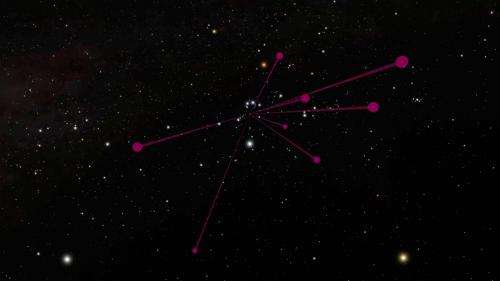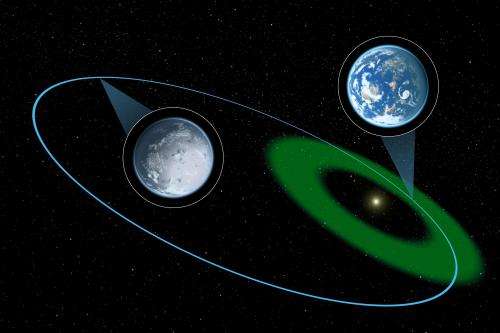Brown dwarfs may wreak havoc on orbits of nearby planets, causing desolation

Planets that move around their stars in circular orbits are a better bet for life than those in elongated orbits when it comes to creating habitable climate conditions, according to a new study.
That's because circular orbits tend to have more stable climates, while an overly elliptical orbit could send a planet into wildly fluctuating seasons and could even move it into and out of a star's habitable zone where liquid water can exist.
On average, the nearly 1,800 exoplanets discovered to date have orbits almost ten times as elongated as Earth's, likely resulting in temperature extremes. In some cases, interactions with other planets in the system could explain the stretched-out orbits. But in other systems, especially those with only one planet, the reason for the elliptical orbits can be challenging to explain.
"The fact that the average should be so high is a mystery we want to answer," said Alan Hulsebus, a doctorate student at Iowa State University and primary author of the paper.
He added:
"Did [the exoplanets] form this way by some unknown mechanism, or were they nudged into those [elliptical] orbits through interactions with another object? Was this a one-time action or something secular? If the latter, is that object still around and can we detect it?"
Hulsebus led a search of the 14 closest planet-hosting stars near Earth for signs of a brown dwarf, a massive object that could potentially shift the orbits of the planets.
The findings were published in the Astrophysical Journal and presented by Hulsebus at the 224th meeting of the American Astronomical Society in Boston, Massachusetts in June.
A tiny tug over time
The two leading models for planetary formation both suggest that planets start out in nearly circular orbits, which corresponds to an eccentricity measurement of 0. Earth's orbit is nearly circular at 0.02, which keeps the planet approximately the same distance from the Sun throughout the year.
An increased eccentricity means that the planet has a more elliptical, or stretched, orbit. Such planets may spend more time far from their stars, creating long, bitter winters. As they draw close to their stars, they could suffer scorching summers, particularly in the hemisphere pointed toward the star.
A planet could have a more eccentric orbit for a number of reasons. For example, collisions during the formation period could knock it out of its circular orbit.
Interactions with other planets could also change how they travel around their stars. Of the highly eccentric planets discovered, 78 percent of those with eccentricities greater than 0.5 have only one planet in the system, Hulsebus said. While the other planets could have been kicked out over the course of their evolution, Hulsebus and his team looked for a third option—the presence of a distant brown dwarf that could wreak havoc on the orbit of planets.
As a failed star which never accreted the necessary mass to start fusion in its core, a brown dwarf can be a few times heavier than Jupiter or reach masses up to 80 times as great. Because orbiting bodies travel more slowly the farther away they are from their stars, a distant brown dwarf may barely move across the sky while an interior planet races around its star. As a result, the two bodies would interact gravitationally at roughly the same time of the inner planet's year. The smaller planet experiences a gravitational tug that pulls it ever-so-slightly away from its star and closer to the brown dwarf. Over time, the process would stretch the orbit of the inner planet, making it steadily more elliptical.

"The brown dwarf perturbs the planet's orbit gravitationally, either on a short or long timescale, and by that induces eccentricity," said Smadar Naoz, an astrophysicist at the Harvard-Smithsonian Center for Astrophysics.
Naoz, who was not involved in this paper, studies the dynamics of planetary systems.
Hulsebus and his team looked at all of the stars within approximately 50 light-years of Earth that are known to have planets, or that have debris disks that could indicate planetary formation. Of the 14 stars in that distance known to have planets, nine hosted at least one planet with an eccentricity greater than 0.1. The search was sensitive to objects that would lie just outside the Solar System's Kuiper belt, the region beyond Pluto.
Although the team is focused on brown dwarfs to explain elongated orbits, it has also been searching for objects around systems that travel along more stable, circular paths. Finding a distant brown dwarf around a planetary system with stable eccentricities could imply that something else is driving the instabilities.
"Even for those systems without eccentric planets, it is important to check for widely separated planets," Hulsebus said. "If they were discovered not to exist—or to only exist—around circular systems, that would be a noteworthy result."
Because brown dwarfs never started fusion, they don't generate the light that other stars produce. In optical wavelengths, scientists rely on light reflected from another star. But starlight overshadows the dimmer brown dwarf in orbit around it. A Jupiter-sized object that lies one thousand Astronomical Units from its star (one astronomical unit, or AU, is the distance Earth lies from the Sun) is a trillion times fainter.
"For every photon your camera collects from the planet, it is slammed by one trillion photons from the star," Hulsebus said.
Instead, the team used the InfraRed Array Camera on NASA's Spitzer Space Telescope to directly image the target stars in search of the signs of a faint brown dwarf. Instead of searching for reflected starlight, they detected the temperature of the brown dwarf as it cooled from its formation.
Of the 14 stars studied, 4 hosted objects with a brown-dwarf-like appearance. Follow-up observations will determine if they are, in fact, brown dwarfs. Three of the planetary systems have eccentricities of greater than 0.1.
For the remaining systems, the team was able to put upper limits on other possibly unseen objects and their orbits.
"We have not eliminated the possibility of perturbing objects in these systems, but we have restricted the parameters that they must have if they exist," Hulsebus said.
Edging out habitability

Scientists tend to regard stable planets with constant temperatures to be better hosts for the evolution of life than those with temperatures that wildly fluctuate throughout the year.
A star's habitable zone is the region around it in which a planet can hold liquid water at its surface, another important ingredient for the development of life. A brown dwarf can affect whether or not an otherwise-habitable planet would remain in its habitable zone.
"If a brown dwarf induces a large eccentricity, so large that tidal forces from the star can shrink the planet's orbit, then it can move the planet in or out of the habitable zone," Naoz said.
Throughout the course of its orbit, the planet might duck in too close to the star, where temperatures would be too hot for it to maintain water, or travel to the outer edges of the habitable zone, where liquid water would freeze.
The brown dwarf's size determines how significantly it will affect inner planets. The more massive the brown dwarf, and the closer it travels to a smaller planet, has an impact on how quickly and dramatically it will affect the planet's orbit.
"The best case scenario for maintaining life on a planet would be to have the changes occur slowly over a long time," Hulsebus said. "This would require a relatively small brown dwarf in a circular orbit, far from its host star."

The greatest wealth of extrasolar planets in recent years have been discovered by NASA's Kepler mission.
"Kepler has been stupendously successful at finding planets, and determining the frequency of brown dwarf companions around those systems would be very interesting," Hulsebus said.
The study of brown dwarfs is limited by the objects themselves. Hulsebus studied the closest planets to the Solar System because those were the most ideal. Brown dwarfs constantly cool, so older, smaller or more distant objects are more challenging to spot.
Because most of the stars that Kepler is studying lie so far from Earth, astronomers would only be able to spot brown dwarfs as close as about 4,500 AUs from their star. That distance is outside of the expected range of where a brown dwarf might have a significant effect on planetary companions, making the detection of brown dwarfs that could interfere with the orbit of planets around Kepler stars impossible with present technology.
"More importantly, we wouldn't be able to see brown dwarfs at this distance," Hulsebus said. "They would be too faint."
Journal information: Astrophysical Journal
Source: Astrobio.net
This story is republished courtesy of NASA's Astrobiology Magazine. Explore the Earth and beyond at www.astrobio.net .



















